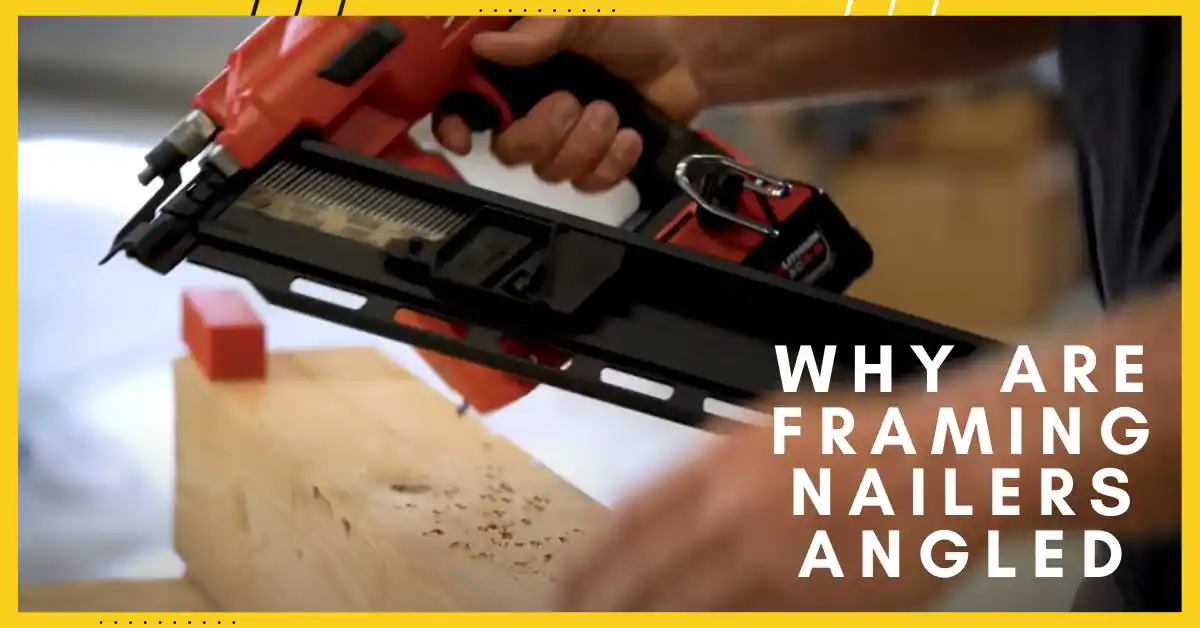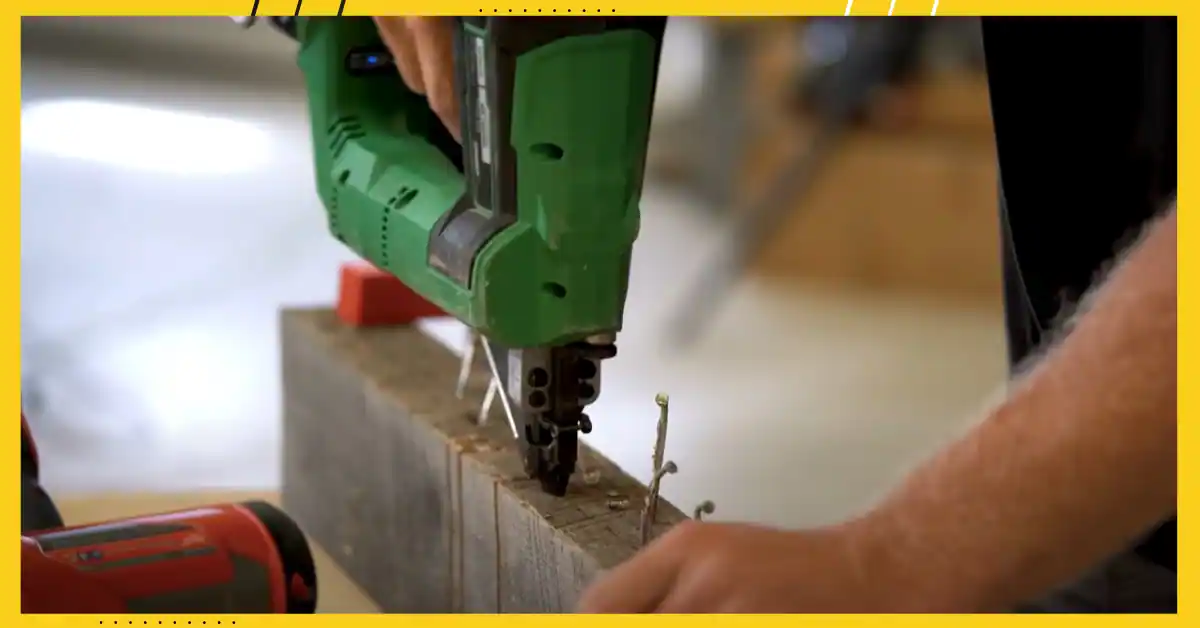Why are framing nailers angled is a common question? Angled framing nailers are designed to make it easier to drive nails into tight spaces. The angled design allows the user to get close to the work piece. Its making ideal for nailing trim and other small pieces.
Angled nailers are great for a figure of reasons. They help to ensure that your nails are driven in at the correct angle, which can be vital when working on framing projects. They also give you more control over the direction of the nail. This can be handy when working in tight spaces.
I am presenting here, why are framing nailers angled? Follow my instructions until I finish my writing. Keep.. Stay tuned!
What is a framing nailer angle?
For securing pieces of wood together, nothing beats a framing nailer. Its purpose is to rapidly and accurately fire nails into wood. The angle of the nail gun is one of the most significant features of its design. The angle determines how the nails will be driven into the wood and can have a big impact on the strength of the connection.
There are three main types of angles used in framing nailers: 15, 21, and 30 degrees. There are benefits and drawbacks to both options. The 21-degree angle is the most often used one. It’s strong enough to keep its shape without being cumbersome to work with. If you need a more powerful connection, you may want to choose a 15-degree angle. However, this angle can be more difficult to use and may cause damage to the wood if not used properly.
For applications where a very strong connection is not necessary, a 30-degree angle may be a good choice. It is the easiest angle to use, but does not provide as much holding power as the other two angles.
Always refer to the manual provided by the manufacturer before using any framing nailer. This will help you understand the tool’s capabilities and What Do Framing Nailer Angles Mean limits, and ensure that you use it safely and correctly.
How to Choose a Framing Nailer
Following these guides is a great step for choosing a framing nailer: Follow as
- Determine if a pneumatic framing nailer or a wireless framing nailer is more appropriate for the job.
- Contrast the stick style with the coil style.
- Check your air compressor for damage.
- Take extra care around frame nailers.
- Keep an eye out for specifics.
Why Do Framing Nailers Come at Different Angles?
In order to understand why framing nailers come in different angles. It is first necessary to understand how they work. A sort of powered instrument known as a framing nailer is a device that drives nails into wood through the use of compressed air. The air compressor is connected to the nail gun by a hose. As well as the operator holds the gun against the wood while pulling the trigger.
The nails are fed into the gun from a magazine, and they are driven into the wood by a piston that is actuated by the compressed air. The angle at which the nails are hammered into the wood is determined by the position at which the gun is held in relation to the wood.
The availability of frame nailers at a variety of angles may be attributed to a few distinct factors. To provide just one example, some viewpoints could be better suited for particular kinds of undertakings. For example, a steeper angle may be better for driving nails into hardwoods, while a shallower angle may be better for softer woods.
Additionally, different angles can provide different levels of accuracy and precision. When working on a particularly delicate or intricate project, a framing nailer with a narrower angle may be less likely to damage the wood. Whichever perspective you choose to follow, it fundamentally relies on the requirements of the job at hand.
Degrees of Difference: Framing Nail Gun Angles
Following degree angles are observed in framing nail gun angles: Like as
- 15-Degree Framing Nailers
- 21-Degree Framing Nail Guns
- 28-Degree Framing Nailers
- 30- to 34-Degree Framing Nailers
Which is Better 21- Or 30-Degree Framing Nailers
There is a lot to consider when trying to decide which framing nailer is best for you. The scope of the task at hand should be your first concern. If you’re only doing small projects around the house, then either a 21- or 30-degree framing nailer will work just fine.
However, if you’re planning on doing larger projects, such as building a deck or shed, then you’ll need to opt for the 30-degree framing nailer. This is because it can handle longer nails, which are necessary for these types of jobs. Another thing to keep in mind is that 21-degree framing nailers are typically lighter and more compact than their 30-degree counterparts.
This can be a big advantage if you’re working in tight spaces or plan on doing a lot of maneuvering. On the other hand, 30-degree framing nailers tend to be more powerful. So, they can drive nails into tougher materials with ease. So, which alternative should you select then?
It’s entirely up to your own specific requirements and tastes. A framing nailer with a 21-degree head angle is a good choice if you’re looking for something that’s both lightweight and simple to use. Choose a 30-degree model if power is your top priority.
What is the Best Angle for a Framing Nailer?
I am assuming you are talking about a pneumatic nailer. The answer is that it depends on the application. For example, when installing sheathing or subflooring, a gun angled at about 30-45 degrees will help prevent blowouts in the wood. When attaching furring strips or doing other finish work, a smaller angle (20-30 degrees) is often best to avoid marring the surface of the wood.
What is the Advantage of Angled Nail Guns?
An angled nail gun is a type of pneumatic tool that helps to drive nails into wood and other materials at a precise angle. It is commonly used in construction and carpentry applications. An angled nail gun’s precision is a major benefit.
When using this type of gun, you can be sure that the nails will be driven into the material at the exact angle that you want. Using a regular hammer and nails would make this mission very challenging. Another advantage of an angled nail gun is that it can save you a lot of time.
If you are working on a project where you need to drive a lot of nails into wood, an angled nail gun can help you do the job much faster than if you were using a hammer and nails. Overall, an angled nail gun is a great tool to have if you need to be precise with your nailing or if you need to do a lot of nailing in a short amount of time.
FAQ:
What is the Difference between 21 Degree And 30 Degree Framing Nailer?
If you’re a contractor, a carpenter, or just enjoy working with wood. You know there are many different types of nail guns on the market. But what makes a 21-degree frame nailer distinct from a 30-degree one? Here’s a brief primer on how to choose the ideal equipment for your next undertaking.
A 21-degree framing nailer is designed for use with thinner lumber and materials. The smaller angle of the gun helps to prevent splitting when nailing into softer woods. Light trim work and other delicate crafts are also suitable uses for this material.
A 30-degree framing nailer is best suited for thicker lumber and tougher materials. The larger angle of the gun gives it more power to penetrate harder woods without splitting them. It’s also great for heavier duty trim work and other tougher projects around the house.
What is the difference between a 21 Degree And 28 Degree Framing Nailer?
When it comes to choosing a framing nailer, one of the most important decisions. You’ll have to decide between a 21 degree and a 28-degree model. Both pneumatic and manual nailers have their uses. Certain tasks may be ideally adapted to one over the other. Here’s a quick breakdown of the key differences between these two types of nailers:
21 Degree Framing Nailer:
-The smaller angle of the nails makes them less likely to split the wood when being driven in, making this type of nailer ideal for softer woods.
-The smaller angle also allows the nails to be driven in at a shallower depth, which can be helpful when working with thinner materials.
-Because the nails are driven in at a shallower depth, they’re less likely to come loose over time. That’s why 21-degree framing nailers are so useful for long-lasting construction.
28 Degree Framing Nailer:
-The larger angle of the nails means they can be driven in deeper without splitting the wood, making this type of nailer ideal for harder woods.
-This deeper driving ability also means that 28-degree framing nailers can hold heavier materials more securely. -However, because the nails are driven in so deeply, they’re more likely to come loose over time.
This makes 28-degree framing nailers best suited for projects where speed and ease of use are more important than long-term durability.
Final Say
Now you clear on-Why are framing nailers angled? If you’re a carpenter, you know that one of the most important tools in your toolkit is a framing nailer. Why, therefore, do framing nailers have to be inclined in the first place? As it happens, there is a very good explanation for this.
When you’re using a framing nailer, the vast majority of the time you’ll be nailing into lumber that’s already been cut to size. This means that the sides of the lumber are usually at an angle, not perfectly perpendicular to each other. If your nailer was also perpendicular, then it would be very difficult to line up the nails with the lumber.
But because framing nailers are angled, it’s much easier to get a precise fit. So, there you have it! The next time you’re reaching for your framing nailer, remember that its angle serves a purpose.




